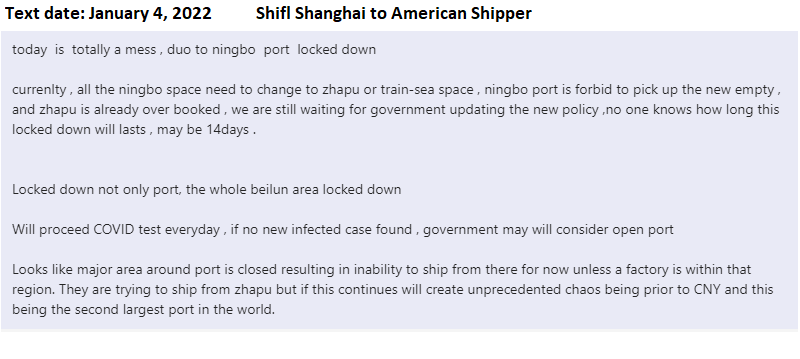The pandemic has entered its third year and the world of trade knows all too well 2022 has started off as a repeat of 2021. The reason? The “zero-tolerance” lockdown measures of China.
The latest partial closure of the Port of Ningbo has forwarders shifting strategies to keep the flow of trade moving. What’s surprising is the naivete of some on this zero-COVID policy that China set in hopes of quashing outbreaks. Like it or not, this is a policy all logistics managers have to educate their customers on. Trade is at the mercy of China’s COVID policy.
What is also surprising is the narrow-minded view that a port is all about the arrival and departure of vessels.
A port is way more than the vessels that it processes. It’s also the land infrastructure — longshoremen, warehouses, trucks and rails that enable the flow of trade to move. Without these critical pieces all operating at 100%, there will be delays. If pieces of the port are closed, locked down or restricted, that constitutes a partial closure.
Despite claims by China that things are “normal” because vessels can enter or leave port, full productivity has not yet been reached. The impact can easily be tracked by the length of time vessels are staying at the port.
Ningbo, a digitally automated powerhouse, still needs people and trucks to operate efficiently. Data from MarineTraffic shows productivity is being impacted, with the time at port creeping up at the Zhoushan Port Complex.
In a LinkedIn post, Nikos Psaltopoulos, COO of MarineTraffic, wrote, “MarineTraffic data via Nikos Pothitakis and Stefanos A. confirms that low productivity out of the Zhoushan Port on the coast of the East China Sea is causing vessel processing delays — with cascading negative impact.”
Digital freight forwarder Shifl has shared various correspondence with American Shipper to give real-time information on the impact of China’s zero-COVID policy. Drayage, just like containers, do not lie when it comes to the reality in the flow of trade.

Later in the day, the first line of this text says it all.

Drayage is key to the movement of goods because it focuses on the human component of trade. If you bog down the workers in the pipes of trade, the movement of cargo slows. Based on this video, trade is going nowhere fast.
Fast-forward several hours. Shabsie Levy, CEO of Shifl, tells American Shipper that based on the drayage updates, he is starting to see some glimmers of hope in moving out containers. How? Not just by words, but by video confirmation on the movement of trucks in and out of the port of Ningbo as more truck drivers get approved on the precious “white list” to go into the port to either drop off or pick up containers.
“It does seem like it’s heading for the better,” Levy wrote to American Shipper, adding that “as more and more truckers are getting onto the white list, we can be hopeful that the disruption will be kept to a minimum. I believe out of 20,000 truckers, as of now 6,000-8,000 are already able to operate on a slower pace with all the new restrictions.
“I guess how it materializes in the next week will really be a factor on the long-term effects of this.”

Until China revokes its zero-COVID policy, these partial shutdowns will continue. This is Ningbo’s third partial shutdown in six months.
To say the supply chain is getting better is just laughable. The men and women navigating the supply chain will ride these cresting waves like they have with keen precision. CEOs of companies need to continue and provide the support needed to help these key individuals to execute their jobs.



